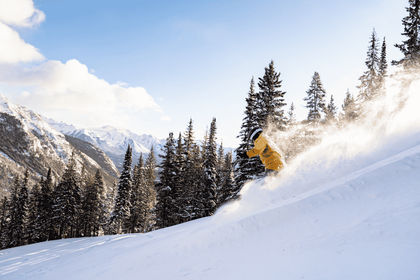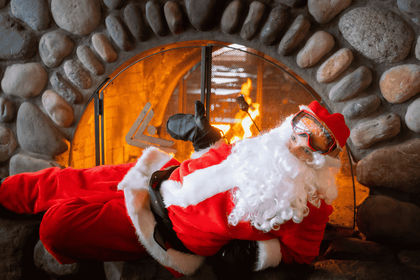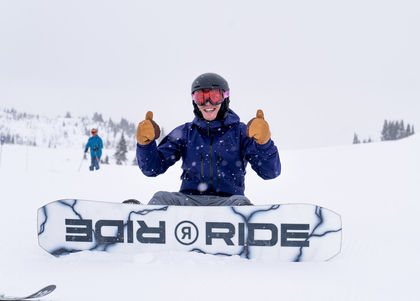
The Ultimate Guide to Getting Started in Ski Photography
Words by Will Lambert
So you’re all set to ride the slopes at SkiBig3, but you want to capture those epic moments to be the envy of all your friends? I'm SkiBig3 Photography Ambassador, Will Lambert, here to help you with a handy guide to getting started in ski photography. Whether you’re shooting with the latest digital camera, a smartphone, or a GoPro, these tips will help you become more successful in nailing the perfect shot.
Planning and Preparation
Organize your gear. A Backpack with a soft padded case for all your electronics is key. This will keep them safe and sealed from snow and moisture. Batteries need to be fully charged and plenty of memory space is a must. Wear gloves that will keep your hands warm but maintain dexterity to control your camera (I use North Face E-Tip Liners).
Keep a shot location list if you’re familiar with the area. Explore your local mountains and make a note of cool areas that catch your eye – viewpoints, interesting trees/rocks and other natural features, specific light in certain conditions. Note all these down so when the time comes, you can head straight there.
Shannon Martin skiing Wild West freeride terrain at Banff Sunshine Village. Photo by Will Lambert.
Check the forecast consistently and develop an understanding of how certain conditions will affect your shots. It doesn’t always drop 30cm of snow overnight, with a cold clear sunny day the next, so tracking the weather and knowing what to expect will improve your chances for great photographs.
Photo by Will Lambert.
Choose your outfit colours. Models' outfits can make or break a shoot. Having an idea about conditions and planning wardrobe choices accordingly is a great move. Bright blue jacket against a blue sky, all-black rider outfit; examples not the best choices to make your model pop! Use the environment to offset the rider against a contrasting colour background to give maximum impact to the photography.
Shoot to the Conditions
It’s the perfect scenario — a sunny bluebird day with fresh snow. What do you do? Shoot the rider offset against the sky, backlit by the sun if possible. This creates “Rooster Tails” and gives great contrast as the light snow particles blow up into the atmosphere.
Photo by Will Lambert.
Sometimes clear skies can be problematic, giving too much contrast between highlights and shadow which leads to an over-exposed photograph. Keep this in mind when shooting and consider if you want the rider to be lit by the light or silhouetted – choose your composition direction depending on this.
In contrast, cloudy or overcast weather isn’t all bad. It gives consistent lighting which means fewer changes to your camera settings in the field. A well-exposed image throughout will mean less post-processing too (more on that later).
Sue Shih snowboarding off the North American chair at Mt. Norquay. Photo by Will Lambert.
On a day where a storm blows in, bringing high winds, flat light, and lots of snow; head to the trees. There’s better visibility in glades and some contrast to the scene to break up that whiteout.
Photo by Will Lambert.
Trees will add depth to the image and often capture falling snow from the sky to give an ethereal look.
Composition Considerations
Choosing the right layout for an image can be crucial in the impact that it makes and the feeling it conveys.
Daniel Thomson skiing in ER3 at Lake Louise Ski Resort. Photo by Will Lambert.
Landscape images are always a hit. Try photographing the setting through the human eye’s perspective. Think small skier/snowboarder vs. huge scenery. This gives a sense of scale and showcases the beautiful location. It can highlight particular landmarks and features to add context to the scene.
Zoom in. Using a longer focal length can remove many distractions that litter a scene, focusing the viewer’s attention solely on what is important. It’s also a great opportunity to pick out details and textures like dew, freshly falling snow and hoar frost.
Lens Choice. The latest smartphones have options such as wide-angle and telephoto, making the pocket camera even more versatile. Wide-angle lenses (<24mm) such as GoPro’s capture a massive field of view – be wary though that they often distort the outer limits of an image, so ensure your subject is central to the frame to remain sharp and impactful.
Angles. Playing around with different perspectives is great fun. Shoot uphill, across the slope, down from high above on a vantage point, low on the snow, or through foliage/rocks/snow/structures. Each of these techniques will give different styles to the image and force the viewer to see your image in the way you intended.
Burst Shooting
Photo by Will Lambert.
Freeze motion by capturing multiple images from a particular turn. This drastically increases your options and chances of getting the shot. On a smartphone, hold down the ‘take photo’ button to achieve this. Then select your choice from the burst. Continuous shooting mode on a digital camera will produce the same result. The more frames per second, the better. Anticipating the shot is vital for burst shooting. Shoot before and after every turn, in bursts to ensure you capture all the magic.
Communication with the Model
So you’ve nailed every step this far? Now you can round up friends, family, some local athletes to photograph and head to the mountain. Working well together and communicating effectively will be paramount to everything. If you have time, scope the location together. Take an example shot you envision to demonstrate the idea to your model. Discuss travel through the scene. Is your rider goofy or regular? You want their front ideally facing the camera. Do they favour a particular side to turn on? If they feel at ease, they’ll look more natural in the image.
Photo by Will Lambert.
Directing a shoot with clear, concise, and specific language is important. “I want you to make a left turn, 15 feet above me, skier’s right of that tree. Then continue in a right turn past me at full speed”. Use snowballs to mark the turn spot. If you’re out of the line of sight, or more than 20m away, use radios to confirm plans and initiate the shooting.... 3,2,1, Dropping! Encourage your model, compliment their efforts – anything to make them feel more at ease. Don’t get them to try too hard, in my experience, people that ignore that I’m there and just ski produce much more authentic images.
Photo by Shannon Martin.
Having a reciprocal interest and work ethic is key. Things don’t always work out the first time. Show the rider the shot, discuss any issues and work together to overcome. Get them to hike back up whilst you reset the scene for shooting. This may mean picking a new pocket of snow to use. It’s much quicker than using lifts! Shoots aren’t always glamourous. There’s a lot of standing around, waiting, checking, talking before the turns are made – but do this right and the results will be worth it.
Navigate Manual Settings
Have a camera with manual settings? Some technical settings to help you achieve those perfect shots. These are put in priority order:
- Shutter speed: To freeze motion, you want a minimum of 1/1000 second shutter speed; I usually shoot at 1/2000-4000 second. This gets the “wave of snow” and captures snow as it falls from the sky. Your model will be tack sharp too.
- Aperture: I normally shoot between f4 – f9 usually. This is image dependant. However, as a rule of thumb — the higher the number, the more likely that more of your image will be in focus. Once you become more comfortable with changing settings in the field, try low apertures like 2.8. These can provide beautiful sharp subject images with blurred (bokeh) backgrounds and give an extremely professional look.
- ISO: This is the last of the three components I change to balance my exposure. Ideally, the lower the ISO, the cleaner the image will look. However when conditions dictate (such as low light), to maintain your shutter speed, bump that ISO up to compensate.
Photo by B&H Photo.
Always take a test shot! New mirrorless cameras have an electronic viewfinder (EVF) so what you see is what you shoot, whereas DSLR cameras have an optical viewfinder (OVF) so either switch to live view mode on your rear screen or check your shot to make sure it’s correctly exposed. You can check your histogram at this point too to see where your data is weighted and if you can adjust your manual settings to gain more light in your image. If your camera allows, shoot in RAW format. You’ll gather much more data in the file (vs. a JPEG) that will give much more flexibility in editing.
Editing
Mt. Assiniboine seen from Banff Sunshine Village. Photo by Will Lambert.
So you’ve spent all shooting with your friends, and taken hundreds of photographs. Don’t let them just sit in your library. Whilst the shoot is fresh in your mind, go through and separate your selects or favourites. Look for emotion on the rider's face, explosions of snow below the skis/board, lack of distractions in the frame. Anything that sets that image apart from the rest.
Then use editing tools such as Lightroom (available as mobile app and desktop) to tweak the image. As a rule of thumb, I slightly over-expose my images in the field so that I can dial it back in the edit suite. As a result, my main tweaks to ski photos are:
- Increase SHADOWS, WHITES, SATURATION, SHARPNESS, CONTRAST
- Decrease HIGHLIGHTS, BLACKS
- Balance WHITE BALANCE, TINT
Every photo is different so the above isn’t a one-stop-shop for editing, but it will give you a place to start. Alter the image to your liking and style.
With the above tips, you should be raring to hit the slopes and snap some shots of your friends. We can’t wait to see what you produce! And be sure to follow along with my ski photography adventures for your winter adventure inspiration on Instagram and Facebook.
-
Ready to explore the SkiBig3 resorts for your favourite photo spot? We’re here to help you book a quick get-away to ski your choice of Banff Sunshine, Lake Louise & Mt Norquay. Or, consider booking a SkiBig3 Spring-Pack, providing the ultimate in Ski & Stay convenience for a local escape at a great price. Skiing in Banff National Park rolls until early May, so there is still time to plan a last minute getaway this season.
Other blog posts


The Ultimate Guide to Christmas in Banff and Lake Louise: Top Events, Festive Activities, and SkiBig3 Holiday Fun

Get Ready to Ride! Richardson’s Ridge Opening at Lake Louise Ski Resort

Top Early Season Tips for Getting Back on Snow This December







